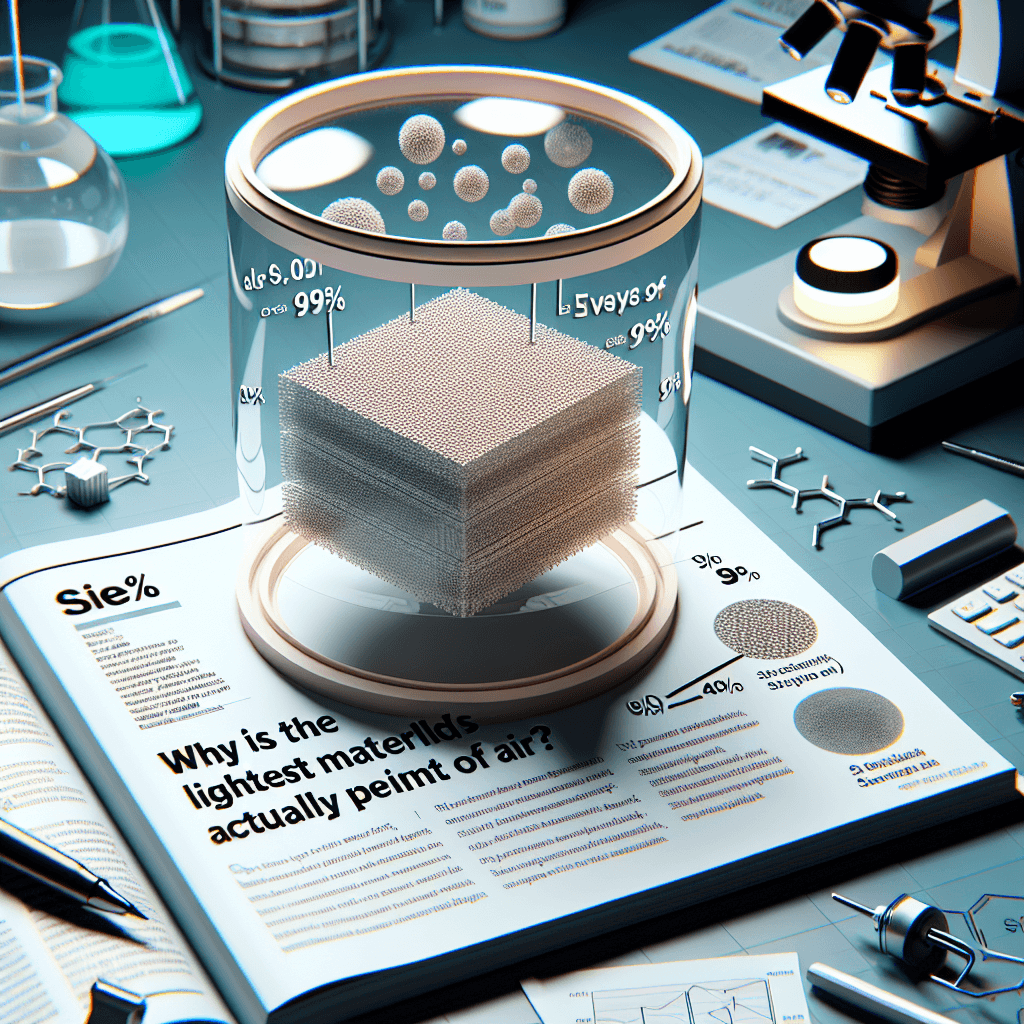Why is the world's lightest solid material actually made of ninety-nine percent air
It looks like a piece of frozen smoke and feels almost weightless—discover the mind-bending science behind how this ghostly material gets its incredible strength from being almost entirely empty space.


Too Long; Didn't Read
TLDR: The world's lightest solid, aerogel, is created by taking the liquid out of a gel and replacing it with air. This leaves a solid, nano-scale scaffold that is mostly empty space, making it incredibly lightweight yet structurally sound.
Blog Post Title: Breathing Solid: Why is the World's Lightest Solid Material Actually Made of Ninety-Nine Percent Air?
What if you could hold a cloud in your hand? A solid object so ethereal and lightweight it can be balanced on the petals of a flower without causing them to bend. This isn't a scene from a fantasy novel; it's the reality of aerogel, a remarkable material often nicknamed "frozen smoke" or "solid air." While it looks otherworldly, the most astonishing fact about aerogel is that it is a solid composed of up to 99.8% air. This seeming paradox begs the question: how can a solid structure be made of mostly empty space? This post will delve into the fascinating science behind aerogel, uncovering how its unique creation process allows it to trap air within a solid, featherlight framework.
What is This 'Frozen Smoke' Called Aerogel?
First, let's clarify what aerogel is—and isn't. Despite its name, it's not a gel. It's a synthetic, porous, ultralight material derived from a gel, in which the liquid component of the gel has been replaced with a gas. The result is a solid with extremely low density and low thermal conductivity. The most common type is silica-based, giving it a ghostly, translucent blue hue due to the way it scatters light.
However, aerogels can be made from various substances, including carbon, iron oxide, and even organic polymers. While delicate to the touch and prone to shattering under sharp pressure, its internal structure is surprisingly strong, capable of supporting thousands of times its own weight. This combination of properties makes it one of the most versatile materials ever created, with applications ranging from NASA space missions to advanced insulation here on Earth.
The Magic of Supercritical Drying: How to Trap Air in a Solid
The secret to creating a solid that's mostly air lies in a sophisticated process called supercritical drying. It's a clever method for removing liquid from a delicate structure without causing it to collapse.
Here’s a simplified breakdown of the process:
-
Start with a Gel: The process begins with a "wet gel," similar in structure to Jell-O. This is essentially a solid, microscopic scaffolding (often made of silica) with its pores completely filled with a liquid, like alcohol or liquid carbon dioxide.
-
The Problem with Evaporation: If you were to simply let this gel air-dry, it would fail. As the liquid evaporates, powerful forces called surface tension would pull on the delicate solid scaffolding. This capillary action would cause the structure to shrink, crack, and collapse in on itself, much like a wet sponge shrivels as it dries. The final product would be a dense, compact material, not an aerogel.
-
Entering the Supercritical State: To avoid this collapse, scientists put the wet gel into a pressure vessel. They then increase the temperature and pressure inside the chamber past the liquid's "critical point." At this specific threshold, the line between liquid and gas blurs, and the substance becomes a supercritical fluid. It's no longer truly a liquid or a gas but has properties of both, allowing it to flow through the gel's pores without any surface tension.
-
The Final Step: With the liquid now in a supercritical state, the pressure is slowly released. The supercritical fluid turns directly into gas and is vented away, completely bypassing the destructive liquid phase. Because there was no surface tension to pull the structure inward, the gel's solid scaffolding is left behind perfectly intact, with its pores now filled with nothing but air.
The result is aerogel: the original solid microscopic network, preserved in its full volume but now impossibly light.
Beyond the Featherweight: Aerogel's Superpowers
Its 99% air composition isn't just a novelty; it's the source of aerogel's incredible abilities. The countless tiny air pockets trapped within its nanostructure make it one of the most effective thermal insulators known to science. The air molecules have no room to move, drastically hindering the transfer of heat. NASA has famously used aerogel to insulate critical electronics on the Mars rovers and to capture stardust particles in space, as the delicate particles can be slowed and trapped in the material without being damaged.
In conclusion, the world's lightest solid material is mostly air because of the ingenious scientific process used to create it. By carefully removing the liquid from a gel while bypassing the crushing forces of surface tension, scientists can preserve its intricate, solid nanostructure. What remains is a ghostly solid that is more air than substance. This "frozen smoke" is a testament to human ingenuity, transforming the emptiness of air into a material with extraordinary properties. From insulating future homes to enabling deep-space exploration, this material made of almost nothing proves to be capable of almost anything.
More Articles

Why does frost on a window form such beautiful, fern-like patterns?
It isn't magic painting your windowpane, but a beautiful quirk of physics. Discover how a single, invisible imperfection on the glass can bloom into an entire forest of icy ferns overnight.

Why do stacked plastic cups sometimes get so impossibly stuck together?
That stubborn stack of plastic cups isn't just stuck; it's being held hostage by a powerful vacuum and the simple laws of physics.

How can a sea slug eat a jellyfish's stingers and then use them for its own defense?
This soft-bodied slug commits the perfect crime, eating a jellyfish's venomous stingers only to wield them as its own deadly defense.